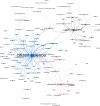What Is Citizen Science?--A Scientometric Meta-Analysis
- PMID: 26766577
- PMCID: PMC4713078
- DOI: 10.1371/journal.pone.0147152
What Is Citizen Science?--A Scientometric Meta-Analysis
Abstract
Context: The concept of citizen science (CS) is currently referred to by many actors inside and outside science and research. Several descriptions of this purportedly new approach of science are often heard in connection with large datasets and the possibilities of mobilizing crowds outside science to assists with observations and classifications. However, other accounts refer to CS as a way of democratizing science, aiding concerned communities in creating data to influence policy and as a way of promoting political decision processes involving environment and health.
Objective: In this study we analyse two datasets (N = 1935, N = 633) retrieved from the Web of Science (WoS) with the aim of giving a scientometric description of what the concept of CS entails. We account for its development over time, and what strands of research that has adopted CS and give an assessment of what scientific output has been achieved in CS-related projects. To attain this, scientometric methods have been combined with qualitative approaches to render more precise search terms.
Results: Results indicate that there are three main focal points of CS. The largest is composed of research on biology, conservation and ecology, and utilizes CS mainly as a methodology of collecting and classifying data. A second strand of research has emerged through geographic information research, where citizens participate in the collection of geographic data. Thirdly, there is a line of research relating to the social sciences and epidemiology, which studies and facilitates public participation in relation to environmental issues and health. In terms of scientific output, the largest body of articles are to be found in biology and conservation research. In absolute numbers, the amount of publications generated by CS is low (N = 1935), but over the past decade a new and very productive line of CS based on digital platforms has emerged for the collection and classification of data.
Conflict of interest statement
Figures






References
-
- Dickinson JL, Zuckerberg B, Bonter DN. Citizen Science as an Ecological Research Tool: Challenges and Benefits. Annu Rev Ecol Evol Syst. 2010;41: 149–172. 10.1146/annurev-ecolsys-102209-144636 - DOI
-
- Danielsen F, Burgess ND, Balmford A. Monitoring Matters: Examining the Potential of Locally-based Approaches. Biodivers Conserv. 2005;14: 2507–2542. 10.1007/s10531-005-8375-0 - DOI
-
- Cohn JP. Citizen science: Can volunteers do real research? BioScience. 2008;58: 192–197.
-
- Cooper CB, Dickinson J, Phillips T, Bonney R. Citizen science as a tool for conservation in residential ecosystems. Ecol Soc. 2007;12: 11.
Publication types
MeSH terms
LinkOut - more resources
Full Text Sources
Other Literature Sources
Miscellaneous

